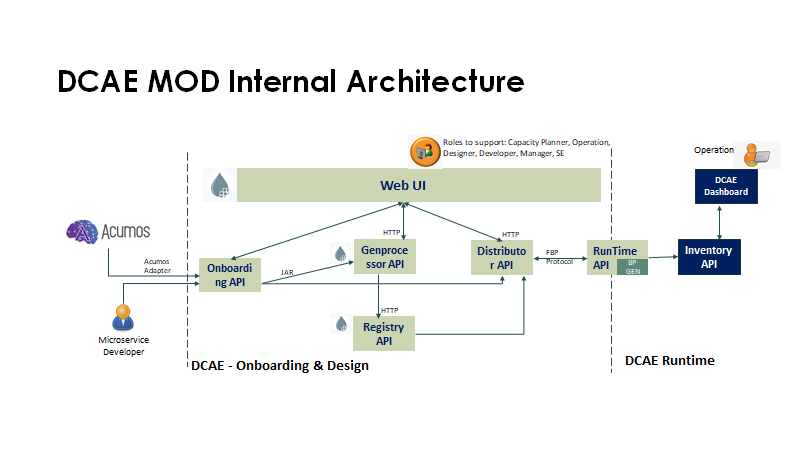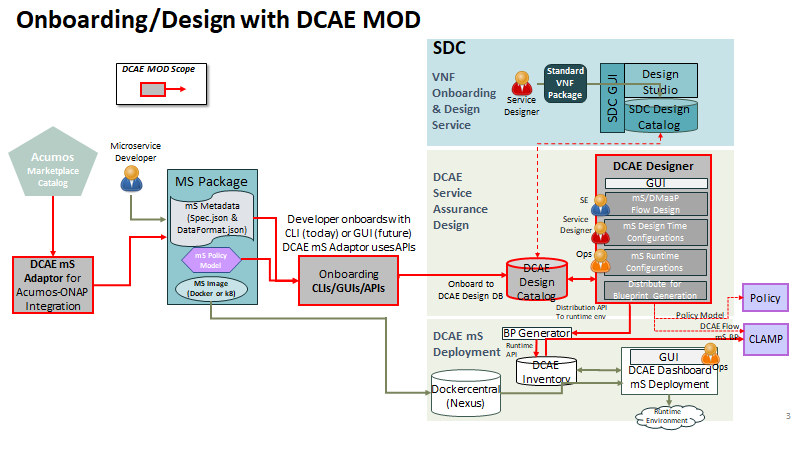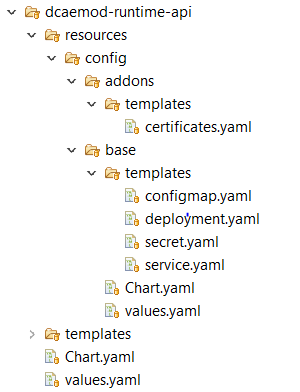DCAE MOD Architecture
DCAE MOD is composed of a mix of components developed in ONAP and other components taken from the Apache Nifi project and modified for appropriate use. The MOD architecture and design was intended to simplify the onboarding and design experience in ONAP addressing below goals.
MOD aims to streamline the construction, management, and evolution of DCAE flows from role to role, from environment to environment, and from release to release. MOD is composed of three functional areas: onboarding, design, and distribution and caters to different user group
The below illustrations describe the architecture of DCAE-MOD and show the usage flow in DCAE MOD


Onboarding API
It is a component developed to onboard models/components/microservices (spec files) into DCAE MOD.
Genprocessor
It has been developed in Java. This project is a tool to experiment with generating a Nifi Processor POJO from a DCAE component spec.
Nifi Web UI
It is a component taken from the Apache Nifi Project but modified for use in the MOD project.
Apache NiFi is a dataflow system based on the concepts of flow-based programming. It supports powerful and scalable directed graphs of data routing, transformation, and system mediation logic. NiFi has a web-based user interface for design, control, feedback, and monitoring of dataflows. It is highly configurable along several dimensions of quality of service, such as loss-tolerant versus guaranteed delivery, low latency versus high throughput, and priority-based queuing. NiFi provides fine-grained data provenance for all data received, forked, joined cloned, modified, sent, and ultimately dropped upon reaching its configured end-state.
The NiFi UI provides mechanisms for creating automated dataflows, as well as visualizing, editing, monitoring, and administering those dataflows. The UI can be broken down into several segments, each responsible for different functionality of the application. This section provides screenshots of the application and highlights the different segments of the UI. Each segment is discussed in further detail later in the document.
The users of Apache Nifi will find that it is used very differently than intended to serve our purpose in the DCAE-MOD project.
Registry API
This component taken from the Apache Nifi project, is a REST API that provides an interface to a registry with operations for saving, versioning, reading NiFi flows and components.
Distributor API
It is a component developed using the Flask framework in Python. It is a HTTP API to manage distribution targets for DCAE design. Distribution targets are DCAE runtime environments that have been registered and are enabled to accept flow design changes that are to be orchestrated in that environment.
Flow Based Programming (FBP)
NiFi’s fundamental design concepts closely relate to the main ideas of Flow Based Programming [fbp].
For more information on how some of the main NiFi concepts map to FBP, check out https://nifi.apache.org/docs/nifi-docs/html/overview.html
Runtime API
It is developed in Java’s Spring Boot framework. It is a HTTP API to support runtime environment for DCAE-MOD. It has two major functionalities:
It accepts changes on the flow-graph via fbp protocol
It generates and distributes helm charts OR blueprints based on the change made on the flow-graph
Build Updates
New Java module - Helmgenerator-core was introduced for Helm charts generation. MOD/Runtime has been enhanced to include this new dependency (inaddition to Bp-generator for supporting cloudify blueprints flows).
Below is snippet from - https://github.com/onap/dcaegen2-platform/blob/master/mod/runtimeapi/runtime-core/pom.xml
<dependency>
<groupId>org.onap.dcaegen2.platform</groupId>
<artifactId>helmchartgenerator-core</artifactId>
<version>1.0.3</version>
</dependency>
Chart Updates
MOD/Runtime Charts has been modified to include under resources, common base templates, Charts.yaml, add-on templates and Values.yaml with placeholder.

The Helmgenerator-core modules uses these template to pull the required dependencies and generate new chart for MS onboarded. The parameters in component-spec provided during onboarding is used for final Values.yaml file generation.
Deployment
The MOD/RuntimeAPI introduces new configuration to identify distribution mechanism. Supported artifactType are BLUEPRINT or **HELM. **
Blueprint – Distribution to Inventory/Dashboard
Helm – Distribution to ChartMuseum
For Jakarta release, the charts configuration has been set to support HELM distribution by default and configured for ONAP-internal chart-museum registry. RuntimeAPI Chart updates https://github.com/onap/oom/blob/master/kubernetes/dcaemod/components/dcaemod-runtime-api/values.yaml
artifactType: "HELM"
registryBaseurl: http://chart-museum:80
basehelmchartlocation: /helm-gen/
Blueprint Generator
This tool allows the user to create a blueprint from a component spec json file. This tool is used by the runtime api when artifactType is set to BLUEPRINT under `RuntimeAPI charts
Helm Generator
This tool allows the user to create a DCAE Services helm chart from a component spec json file. This tool is used by the runtime api when artifactType is set to HELM under `RuntimeAPI charts
Inventory API
Note
Used only under BLUEPRINT mode
DCAE Inventory is a web service that provides the following:
Real-time data on all DCAE services and their components
Comprehensive details on available DCAE service types
DCAE Inventory is a composite API that relies on other APIs to obtain resources on underlying components and uses these resources to compose a DCAE service resource. In addition, DCAE Inventory will store data that is unique to the DCAE service level including:
DCAE service metadata
DCAE service type description and composition details
Relationships between DCAE service and DCAE service types and their respective VNF and VNF types
DCAE Inventory has a REST interface to service client requests. It has a well-defined query interface that would filter result sets based upon resource attributes.
Here, think of it as a back end API for the DCAE dashboard. The runtime posts Cloudify Blueprints to this API so they show up in the DCAE dashboard.
DCAE Dashboard
Note
Used only under BLUEPRINT mode
The DCAE dashboard provides visibility into running DCAE services for operational purposes. It queries the DCAE Inventory for aggregate details on all the running DCAE services and for getting up-to-date status information on DCAE services and their components.
End-to-End Flow
A model/component/microservice can be onboarded by a ms Developer by posting a spec file on the onboarding API. Alternatively, an Acumos model can be onboarded using the Acumos Adapter. Once successfully onboarded, the genprocessor converts converts them to jars and onboards them into Nifi i.e DCAE MOD. These artifacts are now available to use from the Modified Nifi Web UI i.e DCAE Designer.
The registry api offers version control and retrieval for flows. The distributor api can be used to set distribution targets. Once a flow is designed and distributed, it goes to the distributor api which is supposed to post graph changes (in accordance with fbp) to the runtime api. The runtime api generates and distributes deployment artifacts (either blueprints or helm charts) based on the change made on the flow-graph. The generated blueprints are received by the DCAE inventory can then be viewed and deployed from the DCAE dashboard. On helm mode, charts generated are pushed into configured Chartmuseum registry.